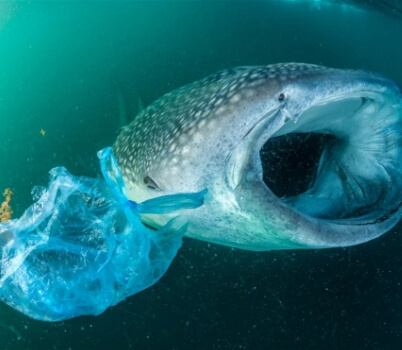Plastic Pollution
Photograph by Thomas P. Peschak, NAT GEO
Plastic pollution has become one of the most pressing environmental issues, as fast increasing production of disposable plastic products crushes the world’s ability to deal with them. Plastic pollution is most visible in developing Asian and African nations, where garbage collection systems are often inactive or don’t even exist. But the developed world, especially in countries with low recycling rates, also has trouble properly collecting discarded plastics. Plastic trash has become everywhere it has prompted efforts to write a global treaty negotiated by the United Nations.
That’s All Happened Because:
Plastics made from fossil fuels are just over a century old. Production and development of thousands of new plastic products quickened, after World War II.
Plastics revolutionized medicine with life-saving devices, made space travel possible, lightened cars and jets, saving fuel and pollution, and saved lives with helmets, incubators, and equipment for clean drinking water.
However, plastics have a material’s dark side: today, single use plastics account for 40 percent of the plastic produced every year. Many of these products, such as plastic bags and food wrappers, have a lifespan of mere minutes to hours, yet they may persist in the environment for hundreds of years.
Plastics move around the world
Most of the plastic trash in the oceans, Earth’s last sink, flows from land. Trash is also carried to sea by major rivers, which act as conveyor belts, picking up more and more trash as they move downstream. Once at sea, much of the plastic trash remains in coastal waters. But once caught up in ocean currents, it can be transported around the world.
Based on NAT GEO:
“On Henderson Island, an uninhabited atoll in the Pitcairn Group isolated halfway between Chile and New Zealand, scientists found plastic items from Russia, the United States, Europe, South America, Japan, and China. They were carried to the South Pacific by the South Pacific gyre, a circular ocean current.”
Grave effects of Plastic Pollution
It seems clear that this amount of a material that isn’t meant to break down can wreak destruction on natural environments, leading to long-term issues for plants, animals, and people.
Some of this main long term effects of plastic pollution are:
Harm to wildlife
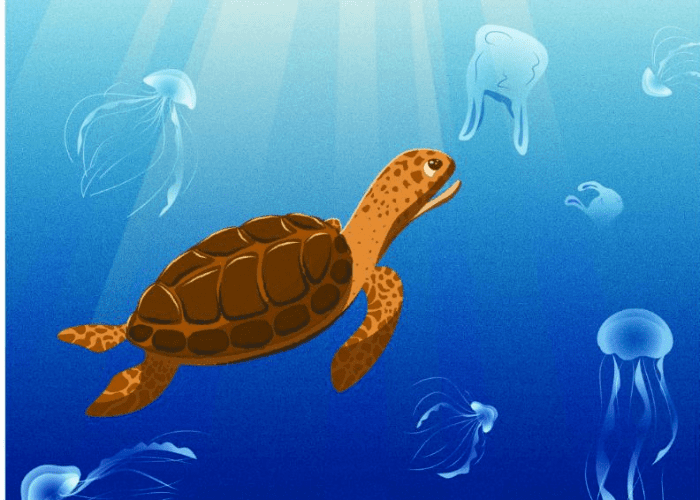
By: https://dribbble.com/shots/8556273-Water-pollution-Turtle-Vector-Illustration
Millions of animals are killed by plastics every year, from birds to fish to other marine creatures. Nearly 700 species, including endangered ones, are known to have been affected by plastics. almost every species of seabird eats plastics.
Most of the deaths to animals are caused by tanglung or starvation. Seals, whales, turtles, and other animals are strangled by abandoned fishing gear or discarded six-pack rings. Microplastics have been found in more than 100 aquatic species, including fish, shrimp, and mussels destined for our dinner plates. In many cases, these tiny bits pass through the digestive system and are expelled without consequence. But plastics have also been found to have blocked digestive tracts or pierced organs, causing death. Stomachs so packed with plastics reduce the urge to eat, causing starvation.
Plastics have been consumed by land-based animals, including elephants, hyenas, zebras, tigers, camels, cattle, and other large mammals, in some cases causing death.
Tests have also confirmed liver and cell damage and disruptions to reproductive systems, prompting some species, such as oysters, to produce fewer eggs. New research shows that larval fish are eating nanofibers in the first days of life, raising new questions about the effects of plastics on fish populations.
Land Pollution
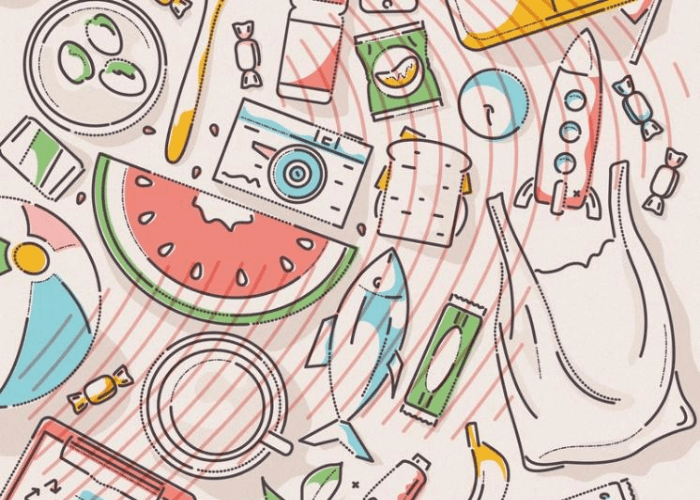
By: https://dribbble.com/shots/6421120-Plastic-pollution
When plastic is dumped in landfills, it interacts with water and form hazardous chemicals. When these chemicals weep underground, they decrease the water quality. Wind carries and deposits plastic from one place to another, increasing the land litter. It can also get stuck on poles, traffic lights, trees, fences, towers etc.
Air Pollution
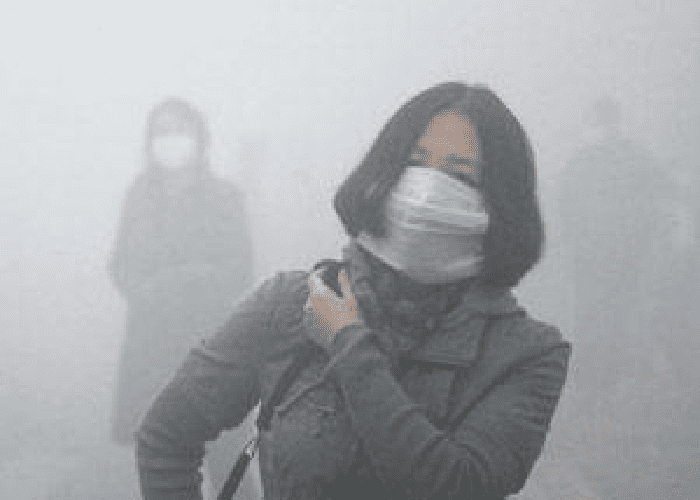
Burning of plastic in the open air, leads to environmental pollution due to the release of toxic chemicals. When humans and animals breath the polluted air, it affects their health and can cause respiratory problems.
Plastic is Toxic
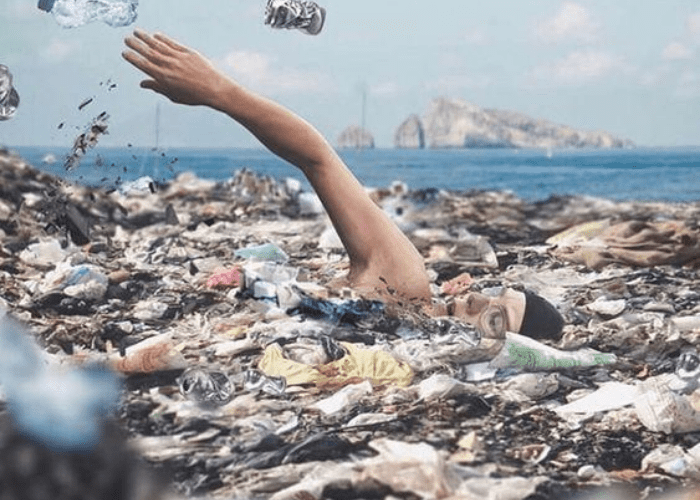
Man artificially makes plastic by using a number of toxic chemicals. Therefore, the use of and exposure to plastics has been linked to a number of health concerns affecting people around the world. The processes of making, storing, disposing of, and just being around plastics can be extremely harmful to living things.
Stop the Plastic!
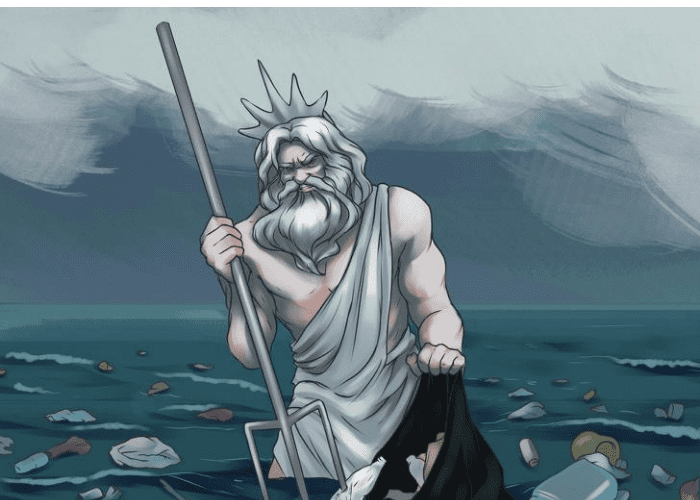
The sad truth is that the only way this problem can be addressed is by individuals and companies around the world agreeing to implement practices that reduce waste on every level. The top tips for reducing plastic waste are:
Shop Friendly
Plastic bags were once a modern convenience but can be efficiently replaced by reusable bags, many of which fold up compactly in order to be portable. Just Carry a bag and always reuse plastic bags as much as possible if you have them.
Bottled Water
People are meant to drink lots of water each day.
However, most plastic bottles are only recommended for single use, and that means that every time someone finishes a bottle, it goes into the trash. Many companies now sell reusable water bottles as a substitute, reducing plastic waste and exposure to leaking bottles.
Educate the Businesses
Speak to local restaurants and businesses about options that they can switch to for packaging, storing, and bagging items. Many companies are starting to come up with excellent low-cost replacements.
Stopping the plastic tide
Once in the ocean, it is difficult—if not impossible—to retrieve plastic waste. Mechanical systems, a litter interceptor can be effective at picking up large pieces of plastic, such as foam cups and food containers, from inland waters. But once plastics break down into microplastics and drift throughout the water column in the open ocean, they are virtually impossible to recover.
Many scientists and conservationists says:
The solution is to prevent plastic waste from entering rivers and seas in the first place. This could be accomplished with improved waste management systems and recycling, better product design that takes into account the short life of disposable packaging, and reduction in manufacturing of unnecessary single use plastics.
